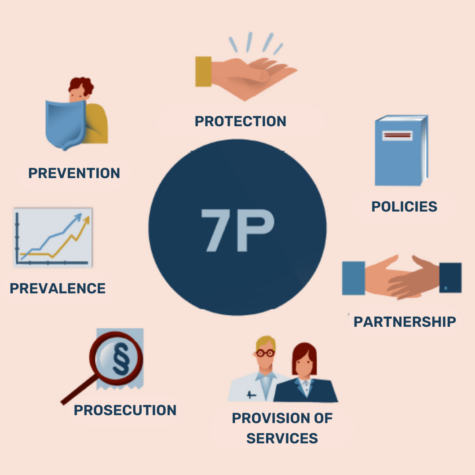The 7P Model
To produce solid and comprehensive knowledge on gender-based violence, UniSAFE has developed an innovative conceptual framework to investigate the mechanisms, social determinants, antecedents, and consequences of gender-based violence in universities and research organisations.
At the centre of the 7P model is the measure of the prevalence of gender-based violence, with the aim of understanding the roles that university and research organisations have to play in prevention, protection, prosecution, provision of services, supported by partnerships and policies.
By studying how prevalence relates to the other six variables of the model, the 7P model marks a significant innovation in research on gender-based violence. This model extends the conventional approach adopted by the United Nations, which focuses on the 3P paradigm of prevention, protection, and prosecution. It also further expands the 4P approach adopted by the Council of Europe in the Istanbul Convention, which includes ‘policies’ as an additional variable.
By expanding its analysis and investigating the role of research organisations in providing services to victims and perpetrators, and how they are supported by partnerships with relevant actors at the international, national, and local levels, the 7P model adopted by UniSAFE provides a truly holistic understanding of gender-based violence in higher education and makes UniSAFE better equipped to provide robust knowledge and translate it into operational tools.

- Prevalence
- refers to data (and data collection) that estimate the extent of gender-based violence and provide information on different forms of gender-based violence.
- Prevention
- encompasses measures and activities implemented to promote change in behaviour and attitudes. These can be awareness-raising initiatives, educational resources, targeted policies, and the dedicated training of professionals in universities and research organisations.
- Protection
- involves cooperative actions aimed at ensuring safety and meeting the needs of potential victims. Some examples include the establishment of transparent reporting processes and the provision of adequate infrastructure for reporting and supporting victims.
- Prosecution
- refers to the disciplinary measures and legal procedures applied to suspected perpetrators, and the specific training given to persons responsible for implementing the measures.
- Provision of services
- relates to the services offered to victims of gender-based violence, their families, and perpetrators, and their dissemination among all staff and the student body. In research organisations, these services can overlap with prevention and protection. Some examples include counselling services, restraining measures for perpetrators, and the reorganisation of hierarchies
- Partnerships
- refer to the involvement of the relevant actors at various levels, including government agencies, civil society organisations, trade unions, and staff and student associations. These actors may work in collaboration to eradicate gender-based violence – for instance, by contributing to the development of specific university procedures or by fostering police and criminal justice cooperation with organisations providing expertise on gender-based violence.
- Policies
- relate to the more comprehensive strategies that respond to the issue of gender-based violence in a structured way. Analysing policies also enables us to capture the dominant discourse that frames gender policies.
